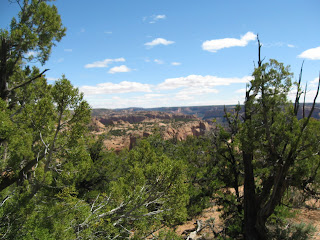It's the end of an era. After two-plus years and thousands of miles, the state of Arizona has been conquered. No, we haven't lifted every rock, nor have we saluted every town and main street, but from the standpoint of passport stamps, it is finished. It's the first state of any consequence on which we've closed the book (we took care of Wyoming in short order, but there's not as much territory to cover), so amidst the sadness, there is joy. Obsessive folks, as we all know, love to cross off that final item from whatever checklist consumes them. We are no different. Admittedly, Navajo National Monument is hardly going out with a bang, given what the Grand Canyon State has to offer, but we'll take it. My heart and lungs will protest, but log it, book it, and let's move forward.
Located twenty miles southwest of Kayenta, Arizona's unofficial stray dog and horse capital, Navajo National Monument is arguably the least enchanting of the region's ruins, primarily because only one of the site's wonders is reasonably accessible to the public. Betatakin (Navajo for "ledge house"), tucked ever-so-logically beneath a canyon alcove, can be viewed from atop the rim after taking the one-mile Sandal Trail. Yes, it is paved and, considering, relatively easy, but the walk back is surprisingly tough. That said, it's important to make that trek, for the view from the back of the visitor center, while lovely, does little to distinguish itself from the eerily similar Canyon de Chelly. Unlike that site, however, Navajo lacks a driving tour, and Spider Rock alone tops anything to be found here.
So one walks down, stares a bit, and eyes the return path with a bit of trepidation. Anything else? One can, theoretically, hike to the bottom of the canyon for a closer look, but tours are ranger-led only, taking up to five strenuous hours. The climb out of the canyon, in itself, is 700 feet. Not in this lifetime, my dear NPS. Not like I'm eyeing your bold-faced warning in the brochure, stating: "If you have heart or respiratory problems, do not attempt this hike." Then there's the Keet Seel ruin (said to be the largest cliff dwelling at Navajo). It may or may not exist, as it's nowhere close to Navajo proper. Hikers not only require a backcountry permit to see it, but they had better be prepared for a 17-mile slog along a "primitive" trail. I can only interpret this to mean that when I drop dead, they'll have to leave my body to the vultures rather than carrying me out. Here, the elevation loss and regain is a staggering 1,000 feet. No question, the pictures of Keet Seel make it extremely appealing, but as I wouldn't seek martyrdom for the awe-inspiring Mesa Verde, I sure as hell won't for a much lesser light of the park service.
At bottom, because of its limitations, Navajo is probably not worth a visit unless completing a stamp run, and at this point, a ruin is a ruin is a ruin. The visitor center is small and shrug-worthy, with displays and random weavers (of the living, breathing variety) spread about with little coherence. Brooke watched the film while I was flopping like a suffocating fish, and while she contends it was fairly decent, I can almost guarantee that I did not need to hear about beans and squash for the umpteenth time. The ancient peoples of the area - Navajo, Hopi, Zuni, and Paiute - deserve our respect and understanding to be sure, but that courtesy does not extend to this monument. Sorry, folks, I'm afraid I'm not overly impressed.
FINAL RATING
3/10






No comments:
Post a Comment